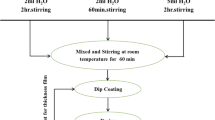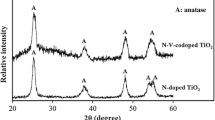Abstract
TiO2 film was prepared on soda-lime glass by sol-gel method. The water contact angle (ϑw) of the fresh TiO2 film is 0°. During storage in air, the surface of TiO2 film is gradually converted to the hydrophobic state. XPS and ITD results reveal that it is due to the adsorption of organic contaminants on TiO2 surface in air ambience. The lost hydrophilicity of TiO2 film can be regenerated by UV illumination.
Similar content being viewed by others

References
Wang, R., Hashimato, K., Fujishima, A. et al., Light induced amphiphilic surface, Nature, 1997, 388: 431–432.
Wang, R., Hashimato, K., Fujishima, A. et al., Photogeneration of high amphiphilic TiO2 surface, Adv. Mater., 1998, 10: 135–138.
Sakai, N., Wang, R., Fujishima, A. et al., Effect of ultrasonic treatment on highly hydrophilic TiO2 surface, Langmuir, 1998, 14:5918–5920.
Liu Ping, Ling Lan, Lin Huaxiang et al., Preparation of the photocatalytic antifogging membrane and its hydrophilic property, Chemical Journal of Chinese Universities, 2000, 21: 462–465.
Wang Yuan, Liu Weijun, Tang Youqi et al., Study on light-induced super hydrophilic TiO2 film, in 2000’ National Conference on Photocatalysis (ed. Fu Xianzhi) (in Chinese), Fuzhou: Fuzhou University, 2000, 59.
Yin Haoyong, Jin Zhensheng, Zhang Shunli et al., Influence of adsorption and photocatalytic decomposition of organic compounds on water contact angle on TiO2 coated glass, Photographic Science and Photochemistry, 2001, 19(2): 81–87.
Wang Shoubin, Zhang Shunli, Jin Zhensheng et al., Application in antifogging of glass surface with the bifunctional thin film for passivation andphotocatalytic decomposition of pollutant adsorption, Chemical Research, 2000, 11: 26–29.
Titheridge, D. J., Barteau, M. A., Idriss, H., Reaction of acrylic acid on TiO2(001) single crystal surface, Evidence of different pathways for vinyl and carboxyl groups, Langmuir, 2001, 17: 2120–2128.
Kim, K. S., Barteau, M. A., Structure and composition requirements for deoxygenation, dehydration, and ketonization reactions of carboxylic acids on TiO2(001) single-crystal surfaces, J. Catal., 1990, 125: 353–375.
Zhu Buyao, Zhao Zhenguo, The Foundation of Interface Chemistry, Beijing: Chemical Industry Press, 1996, 205–235.
Morrison, R., The Chemical Physics of Surface, New York and London: Plenum Press, 1977, 117–121.
Kurtz, R. L., Stockbauer, R., Madey, T. E. et al., Synchrotron radiation studies of H2O adsorption on TiO2(110), Suf. Sci., 1989, 218: 178–200.
Muggli, D. S., Falconer, J. L., Role of lattice oxygen in photocatalytic oxidation on TiO2, J. Catal., 2000, 191: 318–325.
Adamson, A. W., Gast, A. P., Physical Chemistry of Surfaces, 6th ed., New York: John Wiley & Sons Inc., 1997, 347- 381.
NBS Library Compilation (38000 Entries), Vol.1, San Jose: Finnigan Corporation, 1984.
Author information
Authors and Affiliations
Corresponding author
Rights and permissions
About this article
Cite this article
Haoyong, Y., Zhensheng, J., Shunli, Z. et al. Reason for the loss of hydrophilicity of TiO2 film and its photocatalytic regeneration. Sc. China Ser. B-Chem. 45, 625–632 (2002). https://doi.org/10.1007/BF03182534
Received:
Issue Date:
DOI: https://doi.org/10.1007/BF03182534



